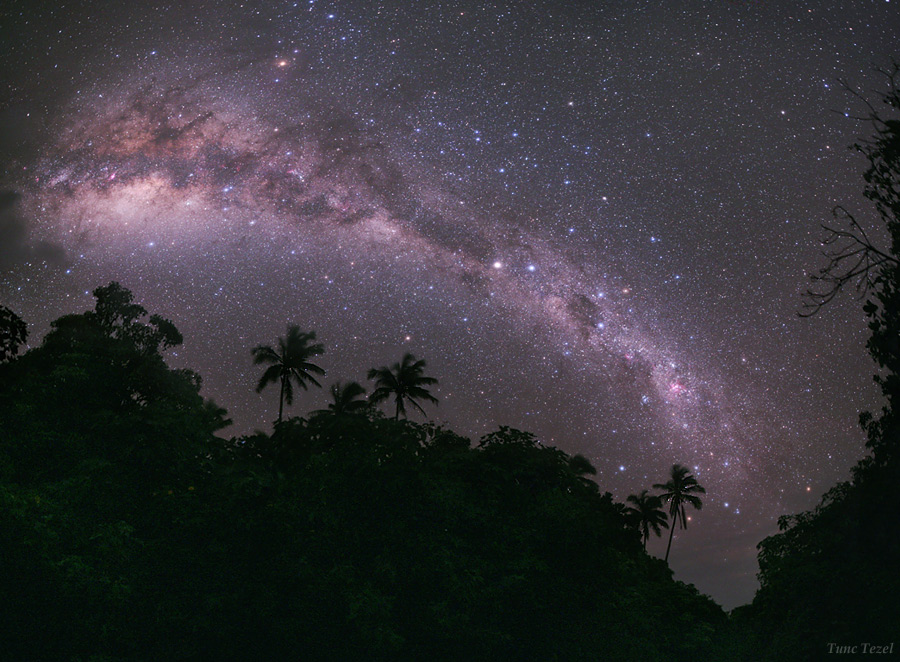Skywatcher Captures Heavenly View From Paradise

Our own Milky Way galaxy shines in this gorgeous skyscape taken by skywatcher Tunc Tezel this summer on the island of Mangaia in the South Pacific.
"When I traveled to see the total solar eclipse of 11th July 2010, I stayed in Oneroa village on the west coast of Mangaia, Cook Islands," Tezel said in an e-mail. "On my first clear night in South Pacific, 7th July 2010, I was out to find clear areas to see the most of the southern skies."
On the left side of the image is the brightest region in the band of the Milky Way, the galactic central bulge, toward the constellations Sagittarius and Scorpius. The bright stars of Alpha and Beta Centauri, the Southern Cross, and the Coalsack dark nebula appear on the right, along the fading Milky Way band.
From Earth, our Milky Way galaxy is visible as a bright band dense with stars that stretches across the night sky. Our solar system is situated in the outer reaches of the Milky Way, which is a spiral galaxy.
We are located on on one of its spiral arms, out toward the edge. It takes the sun (and the planets around it) about 200 million to 250 million years to orbit once around the Milky Way. The sun lies about 26,000 light-years from the center of the Milky Way galaxy, which is about 80,000 to 120,000 light-years across (and less than 7,000 light-years thick). A light-year is the distance light travels in one year, or about 6 trillion miles (10 trillion kilometers).
Tezel used a Hutech modified Canon EOS 5D at ISO 1600 and a 24 mm f/1.4 lens at f/2 to shoot nine 30-second exposures for this panorama. Multiple exposures are made to collect enough light for an image that would otherwise not be evident to the eye.
The second largest of the Cook Islands, Mangaia is home to around 700 people. The 20-square mile (52-square km) island paradise is famous for its lush greenery and tropical vegetation.
Get the Space.com Newsletter
Breaking space news, the latest updates on rocket launches, skywatching events and more!
"It was a delight to look up at night in this south Pacific paradise," Tezel wrote. "I could not get enough of the southern skies. Until a week before that night, I had never seen half of the sky in this panorama. And what a view! There is absolutely no light pollution, yet enough starlight to see and photograph the tropic foreground."
This image was chosen as one of the winners of the Astrophotographer of the Year 2011 Contest held by England's Royal Observatory, Greenwich.
Editor's note: If you have an amazing skywatching photo you'd like to share for a possible story or image gallery, please contact managing editor Tariq Malik at tmalik@space.com.
Follow SPACE.com for the latest in space science and exploration news on Twitter @Spacedotcom and on Facebook.
Join our Space Forums to keep talking space on the latest missions, night sky and more! And if you have a news tip, correction or comment, let us know at: community@space.com.

Space.com is the premier source of space exploration, innovation and astronomy news, chronicling (and celebrating) humanity's ongoing expansion across the final frontier. Originally founded in 1999, Space.com is, and always has been, the passion of writers and editors who are space fans and also trained journalists. Our current news team consists of Editor-in-Chief Tariq Malik; Editor Hanneke Weitering, Senior Space Writer Mike Wall; Senior Writer Meghan Bartels; Senior Writer Chelsea Gohd, Senior Writer Tereza Pultarova and Staff Writer Alexander Cox, focusing on e-commerce. Senior Producer Steve Spaleta oversees our space videos, with Diana Whitcroft as our Social Media Editor.









